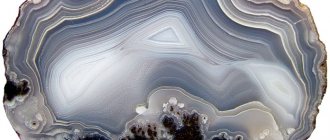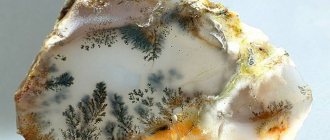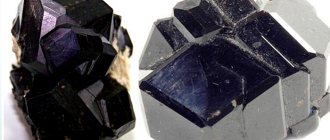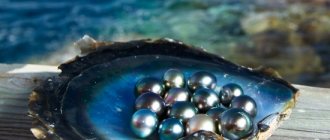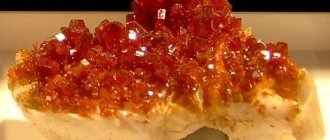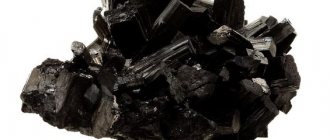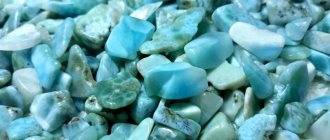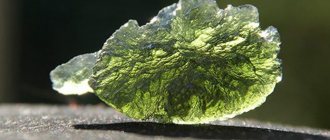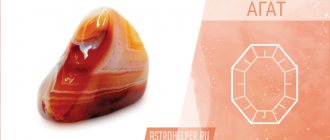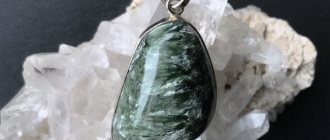| Category | Silicate minerals |
| Title in English | Apophyllitis |
| Formula | (K,Na)Ca4Si8O20(F,OH)*8H20 |
| Group | Apophyllite group |
| Color | Colorless, White, Pale pink, Bluish green, Green |
| Stroke color | White |
| Shine | Glass, Mother of pearl |
| Transparency | Transparent to translucent |
| singonia | Tetragonal |
| Hardness | 4,5 — 5 |
| Cleavage | Perfect |
| Density, g/cm³ | 2,3 — 2,4 |
| Kink | Uneven |
| origin of name | This silicate has an interesting discovery story. At first it was mistaken for zeolite. Later, apophyllite was rediscovered, but under the name “lamellar zeolite”. Then, it was discovered in Sweden under the name ichthyophthalmitis, which translates as fish eye. Soon after this, the mineral was discovered in Spain as a mesotype obtuse. And only in 1808 it turned out that all these minerals were the same. Thus, the name apophyllite appeared, consisting of two Greek words: apo - after, and phyllon - leaf. |
| Morphology | The crystals are shaped like cubes, however, the symmetry is broken and the cleavage is in one direction. |
The igneous stone apophyllite is composed of sodium and calcium silicates. This term refers to a large group of minerals that includes fluorapophyllites, hydroxyapophyllites and natroapophyllites. Apophyllite crystals are most often blue, green, less often pink and light. In the sun's rays they sparkle with a mother-of-pearl or pearl sheen, and due to their high transparency they are difficult to see in water. The peculiarity of apophyllite is manifested in delamination during heating.
Apophyllite deposits
Large gem-quality specimens of an emerald green hue are mined in India near Bombay. Italian deposits are also famous for high-quality apophyllites of various sizes. In addition, deposits of the mineral are known in Ukraine and Georgia.
Production (field)
Apophyllite is an extremely rare gemstone as it is very fragile and brittle. The mineral is found in many deposits around the world, but clear and green stones are mined in several areas of India (Ahmadnagar, Bombay, Jalgaon, Nasik and Pune).
Known deposits:
- Australia (New South Wales);
- Austria;
- Brazil (Rio Grande do Sul);
- Canada (British Columbia, Quebec);
- Czech Republic;
- China;
- Faroe islands;
- Finland;
- Germany (Andreasburg);
- Guam;
- Iceland;
- India (Maharashtra state);
- Ireland (area near Belfast);
- Japan (Niigata and Okoyama prefectures);
- Mexico;
- Russia (Krasnoyarsk Territory, Primorsky Territory);
- South Africa (Kimberley);
- Scotland;
- Sweden;
- USA (California, Colorado, Michigan, New Jersey, North Carolina, Oregon, Pennsylvania, Virginia, Washington State).
History of apophyllite
— Advertising —
Apophyllite Stone - Photo
For the first time, a new and beautiful unknown stone was discovered by the Swedish scientist K. Rinman. In the process of studying the find, he decided to burn the stone in an open flame and it turned out that it had an interesting property - to disintegrate in the cleavage planes when heated, forming different thicknesses of plates.
Only thirty years later, at the beginning of the 19th century, the Frenchman R. Gaüy used this feature to construct the name of the stone. In Greek, "apo" translates to "after" and "phyllite" means leaf-like, indicating the behavior of the crystal at high temperatures.
But at that time, the gem was already well known in Europe. Because of its pearly shine, it was called “fish eye”. And the greenery present in the color of the transparent crystal also gave it the name xylochlore, which is translated from Greek as woody green.
Medicinal properties
The Crystal of Angels has long gained fame as a healing mineral and protector against diseases. In Africa, today it is used to treat malaria and viral infections. In the East, it is used to relieve pain from colic and treat disorders of the gastrointestinal tract.
Modern alternative medicine recognizes that apophyllite has the following set of medicinal properties:
- Facilitates breathing, reduces the frequency and severity of asthma attacks. It is useful for asthmatics to wear this mineral on a chain, like a pendant, so that it is located at chest level.
- Relieves allergy symptoms.
- Accelerates recovery from colds.
- Increases endurance and helps withstand high physical activity.
- Calms the nerves.
- Relieves fever.
- Reduces elevated temperature.
- Reduces inflammation.
Lithotherapists recommend contemplating a stone fish eye once a day for 5-7 minutes. This will calm you down, relieve stress, and prevent a nervous breakdown.
Physico-chemical characteristics of apophyllite
— Advertising —
Apophyllite Mineral - Photo
The mineral consists of potassium, calcium, chromium and vanadium impurities. The shape of the crystals is cube-shaped, short-columnar or tabular. They have a tetragonal system, perfect cleavage, and are fragile. Uneven at the break.
Apophyllite crystals have a pronounced pearlescent luster with a pearl tint, and are colored green or blue. Pleochroism is not typical. Sometimes there are optical effects in the form of a “fish eye”. Transparency is close to crystal. Their hardness on the Mohs scale is 4-5. Density from 2.30 to 2.50. The refractive index is 1.530-1.538. Birefringence 0.002-0.003.
Application
Apophyllite is a valuable and rare stone, therefore it is not used for industrial purposes (as ore). This mineral is considered the whitest of all gems; it has collection value.
Teselite is a rare and desirable exhibit for those who are interested in collecting precious natural minerals. Collectors highlight druses of transparent and translucent crystals as the most spectacular representatives of the apophyllite group.
High-quality, large-sized nuggets end up in the hands of jewelers to be turned into luxury jewelry. They sell out instantly, so you can only see such jewelry in photos. The magnificence of these gems is best emphasized by the facet cut.
Processing a stone fish eye is a complex and labor-intensive task. The mineral is fragile, so it is easy to damage when cutting. It has another specific property that complicates this process. Apophyllite does not tolerate dry, warm environments. Under such conditions, it intensively loses water, becomes discolored, loses its shine and collapses.
A cut gem usually weighs 3-15 carats.
An unmounted medium sized emerald green drusen costs $250-$280. The price of 1 carat of transparent mineral is $250. A collectible sample - apophyllite on stilbite weighing 140 g and dimensions 35x40x75 (from India) costs about $200. Less rare and large specimens sell for $15-30.
Types of apophyllite
Apophyllite belongs to a group of complex silicates that contain potassium, sodium, calcium, as well as water and fluorine. The properties of each sample depend on the percentage of all these elements, depending on which the following types of apophyllites are distinguished:
- Fluorapophyllites or fluoroapophyllites - contain an increased concentration of fluorine, which replaces hydroxyl groups. This variety is capable of fluorescence under ultraviolet light, producing a yellow-green glow.
- With a low amount of fluorine and a high content of potassium, the mineral is classified as hydroxyapophyllite. It is characterized by colorless, green or blue crystals.
- Natroapophyllites are a rare species that contains a high percentage of sodium. Externally it is distinguished by a yellowish or yellowish-brown color.
In addition, apophyllites often additionally contain impurities of other elements, for example, manganese and cobalt. This gives the resulting crystals an exquisite pink color.
How to distinguish from a fake
Apophyllite is almost always found with minerals from the zeolite group, especially in mining areas. Sometimes the gem is identified with zeolites. However, the structure of apophyllite differs from the latter, since they have phyllosilicates, while zeolites have tectosilicate sheets.
The gem also looks similar to carletonite, a rare blue mineral whose deposits are located near Mount Saint-Hilaire, Quebec, Canada. Many believe that carletonite should be included in the apophyllite subgroup.
The magical properties of apophyllite
Apophyllite stone - Photo
In ancient times, priests and sorcerers used apophyllites to perform rituals related to unraveling the mysteries of the future.
It is believed that apophyllites are endowed with the ability to protect the owner from the negative energy that surrounding people bring. In India, amulets with apophyllite are used against the evil eye, and as amulets to protect children. In addition, in this country it is customary to throw an apophyllite crystal into the water every year: as a gift to the gods, and as gratitude for the fish caught in reservoirs during the year.
Apophyllite is a good helper in overcoming stress and anxiety. It is believed that if you look at the sun through apophyllite every day, you can achieve spiritual balance and peace.
History (mythology)
White stones were often used for fortune telling using a “magic crystal”. To do this, it was necessary to look at him with peripheral vision or the corner of the eye.
Mentions of the mineral are found in stories about the practice of walking on hot stones. First, apophyllite is used to achieve a deep meditative state, and then to quickly cool the feet, which is achieved due to the large amount of water in its composition.
Branches of application of apophyllite
Apophyllite is used in jewelry. However, its hardness on the Mohs scale is only 5, and the mineral is quite brittle. Its high-quality crystals look very beautiful when faceted, but during processing they are very easy to damage or destroy, which makes it difficult for jewelers to use the mineral.
In addition, the mineral is unstable in dry and warm environments, and easily loses water. At the same time, it loses color and is destroyed, which also reduces the demand for the stone in the manufacture of jewelry.
Large transparent pale pink specimens of apophyllite of collection value are mined in Transbaikalia.
Where is it used?
The scope of use of the stone is determined by its condition.
The best raw materials are used by jewelers. But there are only a few craftsmen willing to work with fragile stone. After a masterful cut, the colorless stone appears silvery. And people of color compete with the jewelry “elite” in terms of brilliance and beauty.
Most specimens are deposited in mineralogical collections.
Apophyllite colors
The main colors in the apophyllite range are blue and green.
In the sun's rays the stone takes on an amazing pearlescent glow. In addition, it is absolutely transparent and invisible in water. In nature, yellowish, brownish and other shades of gemstones are also found, due to the presence of various impurities in them.
Combination with other stones
Xihollor combines best with colorless stones and green-hued crystals. It is “friendly” with transparent quartz, green calcite and seraphinite. These minerals enhance each other’s magical abilities, strengthen a person’s connection with nature and impart wisdom.
Apophyllite interacts harmoniously with stilbite, an orange, white, pink or brown mineral. It is a hydrous calcium and sodium aluminosilicate. A tandem of such gems sharpens the “sixth sense”, tames a person’s hot temper, and helps to understand oneself and the world around us.
Artificial apophyllite
As such, synthetic apophyllites are not produced. However, technology has been developed to impart a light green color to colorless specimens. To do this, they are irradiated with electromagnetic radiation. Such a stone is not a fake, but its price should be lower than for a similar natural stone.
Varieties and colors
Apophyllite can occur in different shapes - prism-shaped, flat, cubic, with corners, with a stepped or uneven fracture; size - from 3-5 mm to 10-15 cm. The fragile, transparent mineral has a glassy luster with a pearlescent tint. The color of the stone can be either colorless transparent or green, white, yellow, brown, pinkish-red. There is also a rather rare color – black, which is caused by an admixture of hematite.
Reference! An interesting fact is that the IMA (International Mineralogical Association) does not recognize apophyllite as a separate mineral. Apophyllite refers to a group of three minerals with different compositions.
Thus, apophyllite is divided into the following minerals:
- fluorapophyllite – intensely colored, contains a high level of potassium fluoride (KF);
- hydroxyapophyllite – colorless, the composition is rich in potassium hydroxide (KOH);
- natroapophyllite – rare brown, contains sodium fluoride (NaF).
Also read: Heliotrope - the importance of the mineral for humans
However, among collectors, apophyllite is rarely subdivided according to the official classification, and all stones are labeled with a common name.
How to care for apophyllitis
Apophyllite is extremely sensitive to high temperatures.
In dry and hot air conditions it is destroyed. Therefore, products containing it must be protected. They are stored in tightly closed boxes in a cool place. Do not wear during sports activities, saunas, baths. Clean the stone with a soft, damp cloth without using any chemical cleaners that may adversely affect its quality.
Characteristics of the stone
The stone was first discovered by Karl Rinman in 1783 on the island of Gotland in the Baltic Sea. Apophyllite received its name for its ability to exfoliate at high temperatures into plates “apo” - after “phyllon” - sheet. It is also called fish eye, stone fish eye, tesellite, albine.
It is a layered igneous mineral formed in volcanic rocks, in the form of a complex silicate of potassium, calcium and sodium, containing vanadium and chromium. When immersed in water, due to the high degree of transparency, it becomes almost invisible. Optical and physical properties are directly related to the balance of its elements.
The shape can be different: flat, with corners, cubic, prism-shaped. The size can vary from a few millimeters to 10-15 cm. A stone with an uneven or stepped fracture, fragile, transparent, often colorless or transparent white. The luster is glassy, mostly pearlescent. Hardness is not higher than 5 units. according to the Mohs scale.
Varieties
There are three types of apophyllites:
- fluorapophyllite;
- hydroxyapophyllite;
- natroapophyllite.
Depending on the impurities contained in it, the shade of the stone can vary from soft pink and yellow to bluish and green, with varying degrees of saturation.
The main deposits are located in India. This is where the most expensive emerald crystals are mined. They are also mined in Italy, Russia, Georgia, Ukraine, Germany, and America.
Apophyllite and zodiac sign
As a water stone, apophyllite is primarily recommended for zodiac signs associated with the water element (Pisces, Cancer).
Air signs can also comfortably use this stone. Apophyllite is not recommended for Aries, Leo and Sagittarius, since the signs of the fire element get along very poorly with water.
Scope and scope
Zodiac sign
Green Apophyllite is a gemstone for astrological signs such as Gemini, Virgo and Libra. It is believed that it affects the humanitarian character traits of a person.
Blue is suitable for Capricorns, Aries and Scorpios. It has magnetic energy. This mineral is associated with the planets Saturn and Mars.
Medicinal properties
The stone is known for its positive effect on the respiratory system and can be useful in easing asthma attacks (it is recommended to wear it on a chain near the chest). It also neutralizes allergic manifestations and promotes the regeneration of the mucous membranes of the skin.
Apophyllite is considered the best stone for Reiki healing (a Japanese technique for stress relief and relaxation, which also promotes healing). It facilitates bringing the client into a state of deep relaxation and receptivity, while at the same time removing the healer from the process, facilitating a clearer movement of healing energy.
Magic properties
Apophyllite is considered a powerful tool for developing metaphysical abilities.
The mineral improves intuition. The energy of the stone (like that of amethyst) sharpens the senses and makes visions cleaner and clearer. This feature helps you connect with spirits. Thanks to him, you will feel their presence in your life and see many opportunities to change your life for the better.
Green apophyllite activates the heart chakra. It receives and transmits energy. Helps achieve a meditative state, as it helps to concentrate, turn off all external noise, look into yourself and feel the surrounding energy.
The stone enhances the ability to obtain good things in life such as friendship, wealth, love, relationships, marriage and children.
Red heals emotional and physical burnout and disappointment. It gives strength to people with chronic fatigue syndrome.
The mineral releases repressed emotions and helps overcome anxiety, anger and fears.
Blue apophyllite heals grief and clears the mind and body of grief. In this way, it helps achieve inner peace and enhances the ability to accept and cope with loss and emotional pain. It is believed that the stone helps to achieve forgiveness and peace with oneself, as well as to understand and forgive others.
Brown apophyllite brings joy in all aspects of life. The stone is famous for its calming properties, increases self-confidence and faith in life.
It is believed that the presence of a mineral in a room dispels negative energy in it. The people who are in the room have an increased energy level.
Apophyllite is used for inspiration and planning the future - the stone helps to move beyond the past and confidently await future changes.
Stone pyramids are used to open the “third eye” during meditation.
Apophyllite is believed to attract good luck. It also symbolizes upcoming opportunities and bold new endeavors to be involved in. The energy of the stone will not only attract good luck, but will also help you overcome financial difficulties and give you the determination to try again.
Decorations
Generally, apophyllite is not used in jewelry due to its fragility. However, the mineral is often included in gemstone collections around the world. It is the whitest of all known gems. When cut, some uncolored specimens appear silvery in appearance. The mineral is found in deposits all over the world, but the total amount of gems suitable for cutting is small.
Prices for apophyllite products
Gem-quality apophyllites are mined in India. They are either colorless or green, greenish-gray, yellowish-brown. The weight of a cut gem is usually 3-15 carats. On average, high-quality emerald-cut apophyllite is valued at several hundred dollars. The cost of first-class pale green apophyllites reaches $250 per carat.
Price
The range of products that can be purchased ready-made is scarce. Collection material from deposits around the world is much more widely represented (price/RUB):
- crystal (1.5-2.5 cm; Krasnoyarsk region) – 180 – 260;
- nuggets (58-110 g, India) – 850 – 1,200;
- suspension – 900.
The price range for collection stones is thousands / tens of thousands of rubles. Color also matters: pink crystals fetch up to $250 per carat on the world market. The cheapest are gray apophyllites.
Interesting facts about apophyllite:
- Amulets and amulets made of apophyllite are recommended to be purchased by everyone whose activities are related to water (sailors, fishermen, divers and even plumbers).
- There is a legend that God embodied an angel in every apophyllite crystal. Such transparent, pure specimens now contain their holiness and meekness. Therefore, the owner of such a gem will certainly become a kind soul, soften his disposition, and his spirit will become bright.
Apophyllite mineral: properties and description, formula
Apophyllite mineral, unprocessed
Apophyllite is a layered mineral; it is a silicate of calcium, potassium, sodium with impurities.
The chemical formula of apophyllite is (K,Na)Ca4Si8O20(F,OH)*8H20.
It is characterized by a transparent to translucent crystalline structure, medium hardness, high fragility and density, low strength, and perfect cleavage.
Apophyllite crystals are stratified into thick plates and bars with smooth surfaces.
Apophyllite can be colorless, white or with light, even airy pale pink, green, bluish-green shades.
The luster of the stone is glassy, often pearlescent. Such stones are also called fish-eye because of the many microcracks in the fusion planes.
The stone has three mineral varieties: fluorapophyllite (KF), hydroxylapophyllite (KOH), natroapophyllite (NaF).
